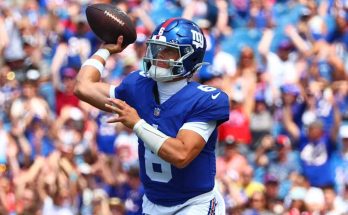Detroit Lions General Manager Brad Holmes has been widely lauded for his masterful rebuild of the franchise. From inheriting a team in disarray to leading them to back-to-back division titles and an NFC Championship appearance, his vision and execution have earned him immense respect. A cornerstone of this rebuild was the acquisition and subsequent long-term extension of quarterback Jared Goff. While Holmes’s public statements about Goff have consistently been effusive, expressing unwavering faith and highlighting Goff’s pivotal role in the team’s success, there’s an underlying viewpoint in the nature of that transaction that, in the unforgiving landscape of the NFL, could indeed prove to be extremely unfortunate in the future.
On May 13, 2024, Jared Goff signed a four-year contract extension with the Lions worth $212 million, including $113.6 million fully guaranteed at signing, with an additional $35 million guaranteed in March 2025, bringing the total to $148.6 million. This deal, averaging $53 million per year, instantly made Goff one of the highest-paid quarterbacks in the NFL. Brad Holmes explicitly stated, “He’s earned an extension. It’s important, it’s a high priority for us. Both sides are working really, really hard. These things just take time.” He emphasized his “faith that it’s gonna get done” and praised Goff’s performance, noting that he’s “performed at a high level” and they “still feel good about where he’s at.”
Holmes’s perspective, at the time, was entirely logical and perhaps even necessary. Goff had revitalized his career in Detroit, proving to be a capable and often excellent signal-caller within the Lions’ offensive system. He demonstrated leadership, resilience, and an ability to execute the aggressive, high-scoring offense crafted by Ben Johnson (and now John Morton). Coming off a season where he led the team deep into the playoffs, locking him up seemed like a no-brainer to ensure continuity and reward performance. The view was clear: Goff was the quarterback to lead the Lions into their competitive window, and paying him top-of-market was the cost of doing business for a successful NFL QB.
However, the “unfortunate” viewpoint isn’t about Goff’s current ability or leadership. It’s rooted in the structural nature of top-tier quarterback contracts in the modern NFL and the inherent gamble they represent, especially when paid to a quarterback not consistently in the elite, top-5 tier.
Here’s why Holmes’s viewpoint, while understandable at the time, carries significant future risk:
1. The Escalating Quarterback Market: The NFL quarterback market is in a constant, relentless inflationary spiral. Every year, a new contract resets the bar, pushing the average annual value (AAV) higher and higher. When Goff signed his extension, $53 million per year placed him as the second-highest paid QB by AAV. But within months, other deals will likely surpass that. For example, Dak Prescott is projected to reach $60 million AAV, and others like Tua Tagovailoa and Brock Purdy have already signed extensions in the $53-55 million range.
The problem for the Lions is that Goff, while very good, is not widely considered in the same tier as a Patrick Mahomes, Josh Allen, Joe Burrow, or Lamar Jackson. He is a high-level facilitator, excellent in a clean pocket, and thrives with strong protection and playmakers around him. But when the pocket collapses or the play breaks down, he doesn’t consistently possess the improvisational magic or elite athleticism of the true top-tier quarterbacks who can elevate an entire offense regardless of surrounding talent. By paying him top-tier money, the Lions are paying for elite-tier production, and if Goff’s performance dips, even slightly, or if his supporting cast falters, the contract quickly becomes an albatross.
2. Cap Hit Structure and Future Flexibility: While the 2024 and 2025 cap hits for Goff’s extension are manageable ($27.2M and $32.6M respectively), they explode in subsequent years:
- 2026: $69.6 million
- 2027: $54.6 million
- 2028: $61.6 million
These are astronomical numbers. The $69.6 million cap hit in 2026, in particular, stands out. While the overall NFL salary cap is projected to rise, that percentage of the cap dedicated to one player could severely restrict the Lions’ ability to retain other key players or acquire new talent.
Spotrac projects the Lions to be over the 2026 salary cap by over $54 million. While they have cap space for 2025 (around $40 million) that can be rolled over, and restructures are always an option, Goff’s massive cap hit in 2026 and beyond will be the primary driver of their cap challenges. They’ve already locked up Amon-Ra St. Brown and Penei Sewell with large deals, and Aidan Hutchinson’s massive extension is looming after 2026 (they picked up his fifth-year option for 2026, but a long-term deal will come soon after). Keeping all of these foundational pieces, while paying Goff a significant portion of the cap, will be an ongoing tightrope walk.
Holmes’s viewpoint of “he’s earned it” is commendable from a player perspective, but the GM’s job is also to manage the long-term health and flexibility of the salary cap. The structure of this deal significantly limits that flexibility in the critical years when the Lions are still theoretically in their prime Super Bowl window.
3. The “Good Enough” Trap vs. “Elite” Cost: Jared Goff is clearly “good enough” to win with a strong team around him. He showed that by leading the Lions to the NFC Championship game. However, the NFL is increasingly becoming a league where truly elite, transformative quarterbacks elevate their teams. The money paid to Goff places him in the tier where those “transformative” quarterbacks reside, not just “good enough” quarterbacks. If the Lions reach a point where they believe they need more than “good enough” to win a Super Bowl, moving on from Goff due to his contract would be incredibly painful.
The dead cap hits are significant, particularly in the earlier years of the extension. For example, a pre-June 1st trade or release in 2025 would incur a $96.4 million dead cap hit. Even in 2026, a pre-June 1st move would result in a $63.8 million dead cap hit. This effectively locks the Lions into Goff for a significant portion of this contract, regardless of future performance or potential regression.
4. The Risk of Quarterback Regression/Injury: While no one wishes it, the reality of the NFL is that player performance can regress, and injuries are always a threat. Should Goff’s play decline due to age, injury, or simply a less effective supporting cast (coaching changes, player departures), the Lions would be stuck with a massive financial commitment to a player no longer delivering top-tier value. This is the ultimate “unfortunate” scenario.
5. Delaying the Inevitable (or the Next QB Search): By extending Goff, the Lions have pushed any serious consideration of their long-term quarterback future further down the road. While Hendon Hooker is on the roster, his development path is still uncertain. The Goff extension means the Lions likely won’t be in a position to draft a top-tier quarterback prospect for several years due to their financial commitment. If Goff’s play eventually does fall off, or the team feels they need an upgrade, they will be forced into a difficult situation of either riding out a massive contract or absorbing huge dead cap figures, all while needing to find their next franchise QB from a less advantageous draft position.
Brad Holmes’s decision on Jared Goff was made with conviction, based on recent success and a desire for stability. It was a move that cemented their core and aimed to seize a championship window. However, the viewpoint that “he’s earned it” and the subsequent financial commitment places the Lions in a precarious future position. The unforgiving nature of NFL contracts, the ever-rising quarterback market, and the immense cap flexibility sacrifices required to pay a non-elite quarterback at an elite level, combine to create a scenario that could very well turn out to be extremely unfortunate for the Detroit Lions down the line. It’s a risk they willingly took, and time will tell if the reward truly outweighs the potential long-term cost.


